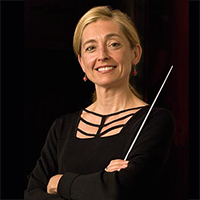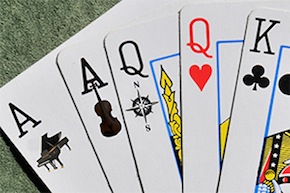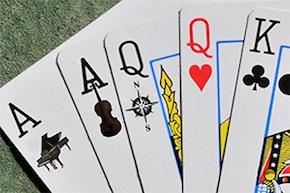
BluePrint Artistic Director and Conductor Nicole Paiement dealt two pairs of intriguing ensemble works with heartfelt moments to an appreciative audience in the San Francisco Conservatory’s Hume Hall on Saturday. That it was not a full house meant that many missed one of the better concerts of the season, unfortunately. Two concertos and two vocal works were revealed, each of which provided interesting cross-comparisons.
A pair of ace soloists took on the concertos. To conclude the first half of the concert, Naumberg Award winner and Conservatory faculty member Axel Strauss performed a work dedicated to him, local composer Kurt Rohde’s 2010 Concertino for Solo Violin and Small Ensemble. To begin the second half, Conservatory graduate Keisuke Nakagoshi exercised Erwin Schulhoff’s 1923 Concerto for Piano and Small Orchestra, Op. 43. Both pieces provided challenges for the two performers, vastly different roles for soloist vs. ensemble, and numerous rewards to the listener.
In Rohde’s concertino, the violin dominates exclusively, with difficult passagework that Strauss executed deftly. The seven-person accompanying ensemble provides tinges of color here, flickering reflections there, while the soloist explores elaborations of clearly stated motives. The three movements are dubbed Motto (motion), Sotto (under), and Rotto (broken), a wry choice that has inspired me to name the next movements I write Ping, Pang, and Pong. The meat of the work occurs in the second movement, the longest of the three, where long lines in the violin become agitated and impassioned at times amid a satisfying structural integrity — so satisfying, in fact, that the very brief Rotto sounded like an afterthought by comparison. With this piece, Rohde has again shown that John Adams is not the only composer with class who is active in the Bay Area.
Dada Firecracks

Schulhoff’s concerto, in contrast to Rohde’s, allows the ensemble to dominate, with the piano executing the primary melodic material only occasionally. It is structurally more diffuse, being more a suite of nine short movements than the “concerto in one movement” that Schulhoff called it. Nevertheless, its dollops of French-school-infused orchestration and abundant melody are irresistible, not to mention the jazz and dada elements firecracking the concluding sections. Nakagoshi commanded his part with stature and technical élan. The chamber orchestra on the whole did a fine job, though seeming out of sync a couple of times. I was only a bit disappointed in the dryness of the solo work in the “Alla zingaresca” section.
Two women brought to life respective vocal works of John Harbison to begin and end the concert. Julienne Walker, a second-year graduate student, brought her gorgeous instrument to the song cycle North and South, and mezzo Erin Neff concentrated her vocal talent on a superb characterization of Myrtle in Act 2, Scene 4, from Harbison’s opera The Great Gatsby. Neff was joined by a baritone, the equally dramatic Bojan Knezevic, as her husband, Wilson.
Rohde has again shown that John Adams is not the only composer with class who is active in the Bay Area.
North and South is a beautiful cycle of six songs to texts by the acclaimed poet Elizabeth Bishop. The program was deficient in not mentioning that the sixth song, “Dear, My Compass,” was not performed; also, the text of the last verse of the fifth song was inadvertently omitted. In addition, when texts are included, I would advise house managers at the Conservatory to keep the lights up at all times to allow them to be read. Walker’s tone was exquisite, a pleasure to hear even if her soprano seemed a bit high for the mezzo part at times. Her dependency on sheet music restricted much of the facial and bodily expression she could have brought to the evocative music. Nevertheless, I was very impressed with her rendition of the moving “Breakfast Song,” a poem rescued from oblivion by a man who copied a draft of it, unbeknownst to Bishop, a few years before she died. The original was never found.The scene from Gatsby was a preview of the new chamber version of the opera to be presented next February. I enjoyed the revised version of the work done in Chicago in 2000. So far as I know, it has not been performed since. Harbison recently arranged an orchestral suite of the music, and the chamber version, orchestrated by the Conservatory’s Jacques Desjardins, should do much to spread this quality opera regionally. The Chicago version cut some of the wordiness complained about in reviews of the Metropolitan Opera premiere. I hope Harbison cuts even more with Desjardin in this next version.
Schulhoff’s dollops of French-school-infused orchestration and abundant melody are irresistible.
In 2000, I felt the scene performed Saturday was the highlight of the opera, and was glad to hear it again, especially so fervently sung. Neff’s gestures, facial expression, and fine voice effectively portrayed Myrtle’s longing for her lover, while Knezevic’s Wilson, suspecting the worst of his cheating wife, looked and sang like he was ready to strangle the nearest person in the audience. (If you go in February, don’t get a front-row seat.) Judging from their rendition, and the superb orchestration by Desjardins, I eagerly await the remake.In reviewing the Chicago program of the opera, printed in a pre-9/11 America, I couldn’t help groaning at an ad produced by The Harris Bank on the inside front cover. A 30s-something man with a glass of champagne, feet in the air, rear on a park bench, cheers wildly to himself in a rain shower: “SUDDENLY, you have money,” it declared, “Now what?”
My, how things have changed since then! May the downsizing do Gatsby well.

